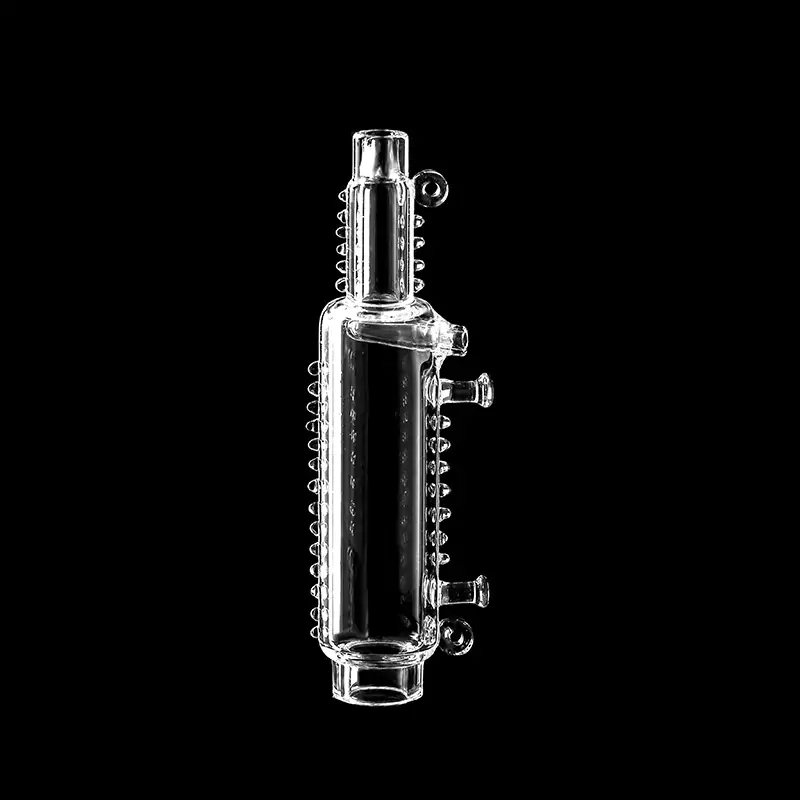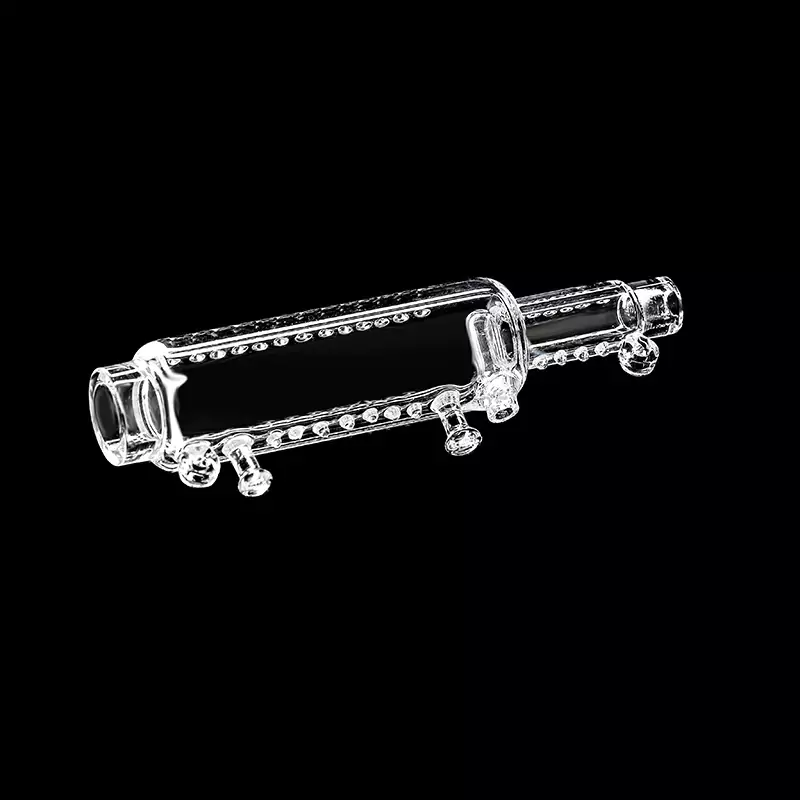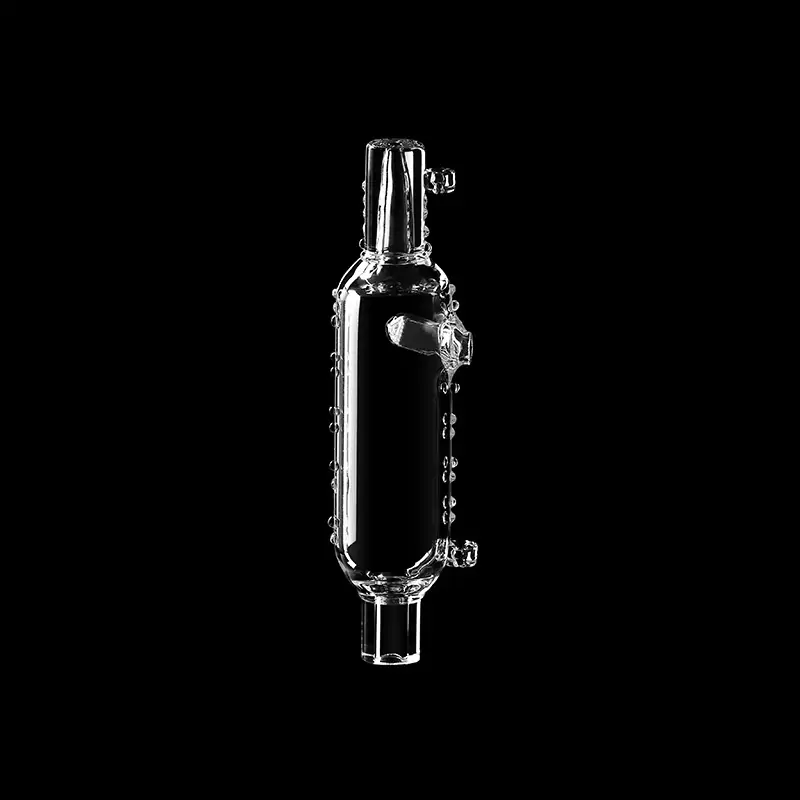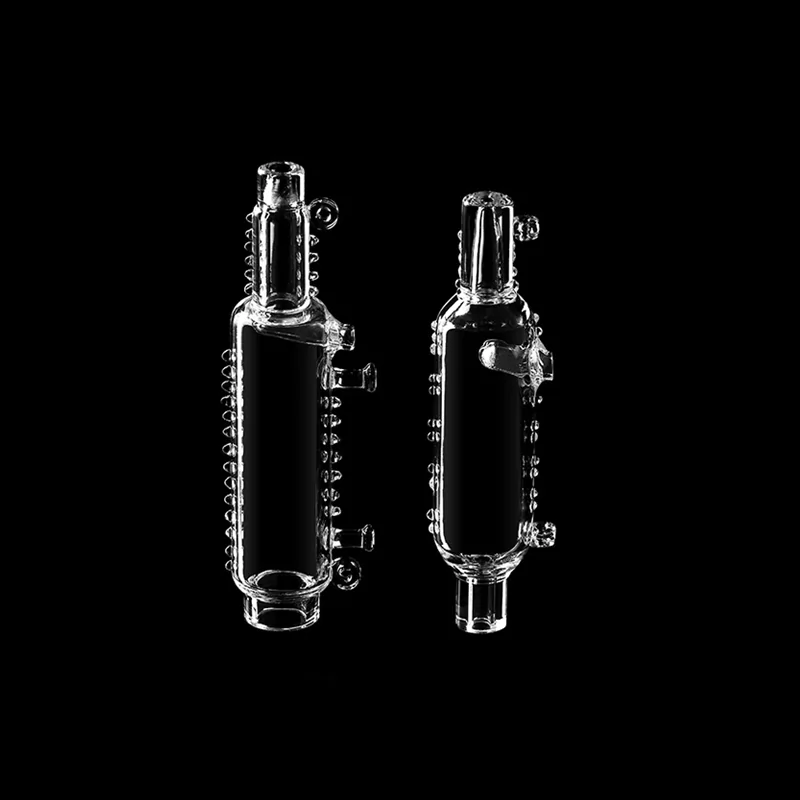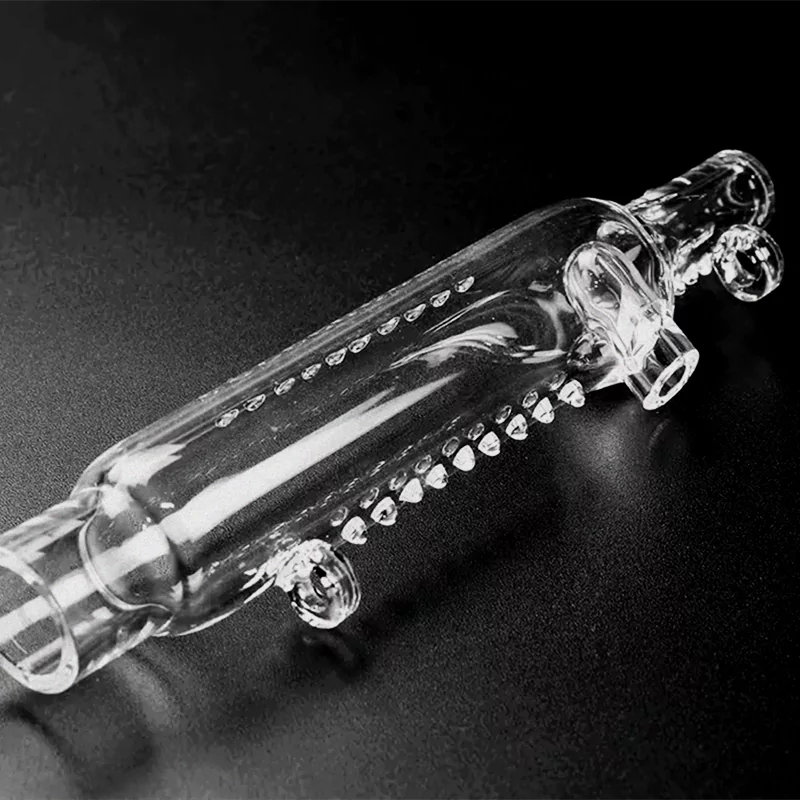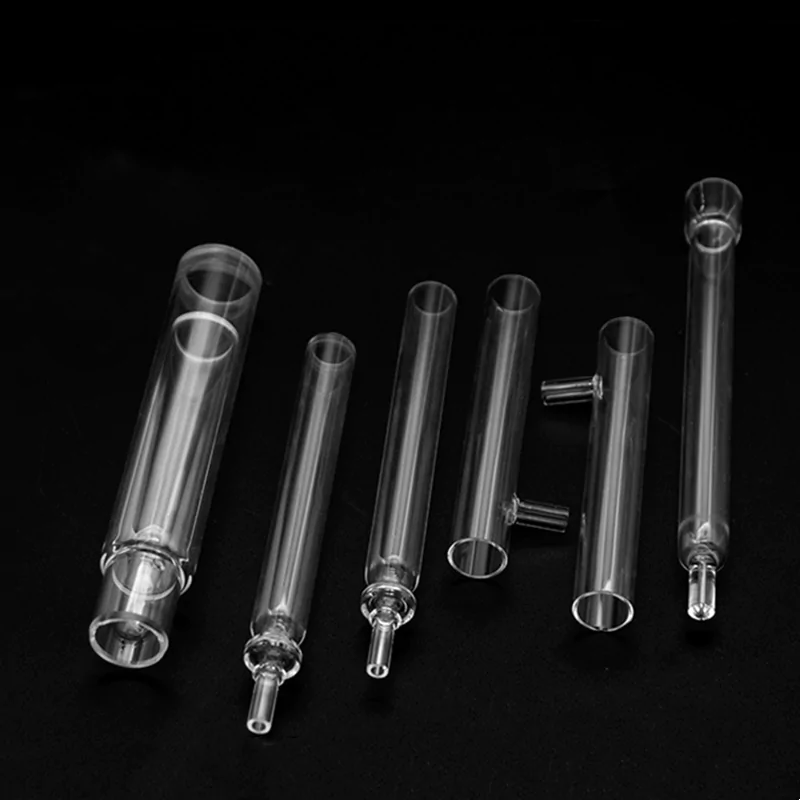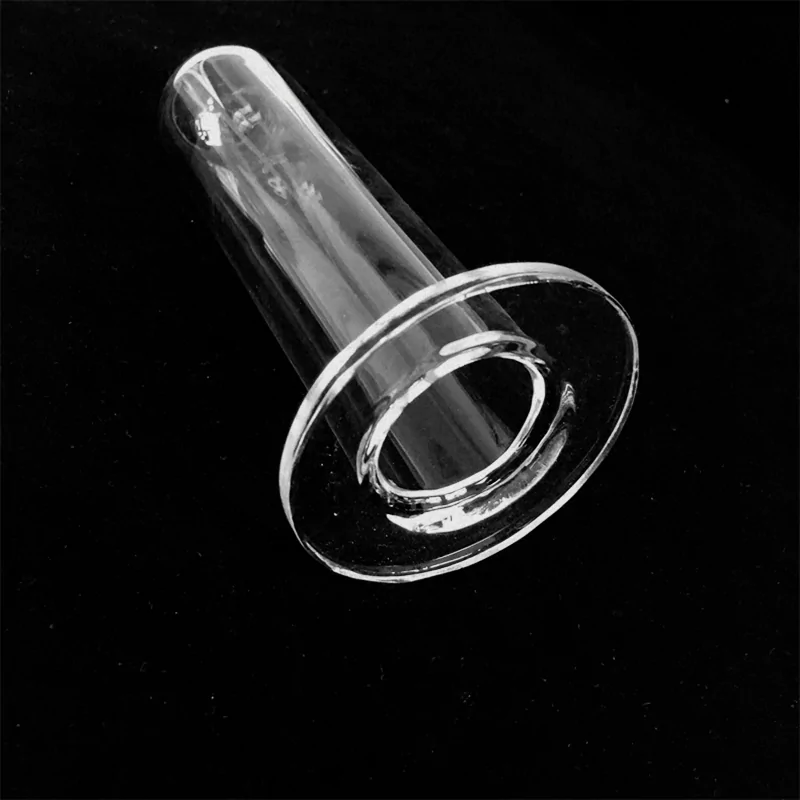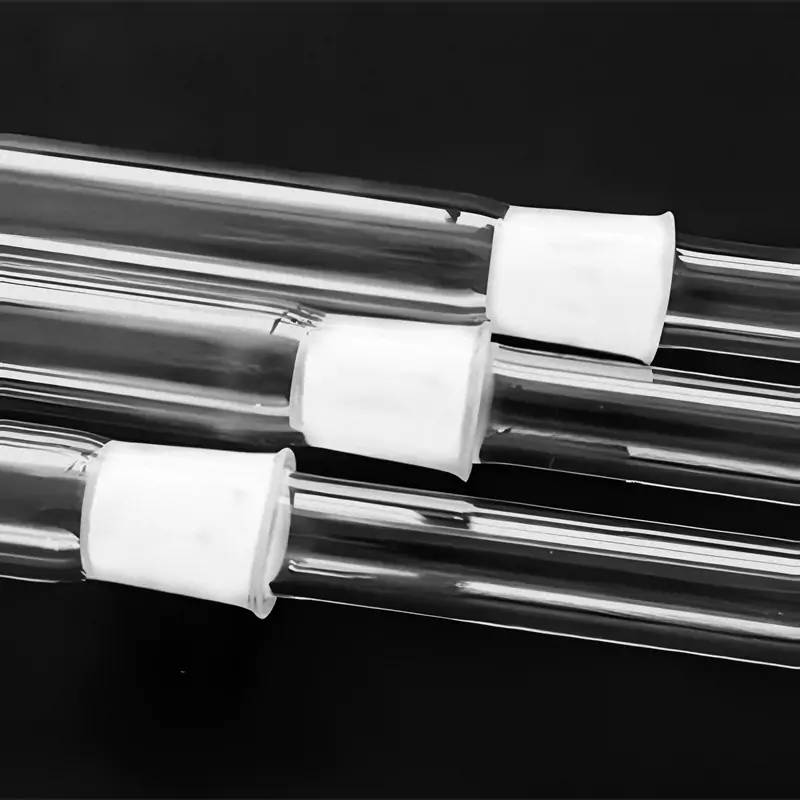- Início
- /
- Tipos
- /
- Tubo de quartzo
- /
- Digestão de quartzo validada por processo personalizado...
Tubo de digestão de quartzo validado por processo personalizado para laboratórios de testes regulamentares - TOQUARTZ®.
Principais recursos do tubo de digestão de quartzo
Os tubos de digestão de quartzo para laboratório TOQUARTZ® são projetados para proporcionar desempenho superior em aplicações exigentes de química analítica. Fabricados com quartzo fundido de alta pureza, esses recipientes combinam propriedades térmicas, químicas e mecânicas excepcionais, essenciais para a preparação precisa de amostras.
Estabilidade térmica
Opera de forma confiável em temperaturas contínuas de até 1100°C com capacidade de exposição de curto prazo de até 1200°C. Apresenta coeficiente de expansão térmica extremamente baixo (5,5×10-⁷ /°C) para excelente resistência a choques térmicos durante ciclos rápidos de aquecimento e resfriamento.
Resistência química
Resiste a ácidos agressivos, incluindo HNO₃, HCl e H₂SO₄, sem degradação ou contaminação. Mantém a pureza da amostra durante os processos de digestão com lixiviação mínima de elementos, essencial para a análise de traços de metais.
Opções de conectividade
Disponível com várias portas de conexão, juntas de vidro esmerilhado e acessórios personalizados para integração com os sistemas de laboratório existentes. As configurações personalizáveis de entrada/saída suportam fluxos de trabalho analíticos específicos e requisitos de compatibilidade de equipamentos.

- Quartzo fundido com teor mínimo de elementos residuais
- Transmissão >90% na faixa de 200-2500nm
- Tolerâncias dimensionais rigorosas: ±0,1 mm
Especificações do tubo de digestão de quartzo
Os tubos de digestão de quartzo TOQUARTZ® são fabricados de acordo com padrões exatos para garantir o desempenho ideal em aplicações analíticas exigentes. Cada tubo é submetido a um controle de qualidade abrangente para verificar a precisão dimensional e as propriedades do material.
Propriedades do material
| Parâmetro | Valor |
| Composição do material | Quartzo fundido de alta pureza (SiO₂ ≥99,995%) |
| Densidade | 2,2 g/cm³ |
| Coeficiente de expansão térmica | 5,5 × 10-⁷ /°C (20-1000°C) |
| Ponto de amolecimento | 1730°C |
| Temperatura de trabalho | Contínuo: 1100°C | Curto prazo: 1200°C |
| Condutividade térmica | 1,4 W/m-K a 20°C |
| Resistividade elétrica | 7 × 10⁷ Ω-cm a 20°C |
| Resistência química | Excelente resistência a todos os ácidos (inclusive HF), exceto ao ácido fosfórico em altas temperaturas |
| Transmissão de UV | >90% a 200-2500nm (1 mm de espessura) |
Dimensões padrão
| Parâmetro | Valor |
| Faixa de diâmetro interno | 20 mm - 50 mm (padrão), tamanhos personalizados disponíveis |
| Espessura da parede | 1,5 mm - 3,0 mm (tolerância de ±0,1 mm) |
| Comprimentos padrão | 100 mm, 150 mm, 200 mm, 250 mm, 300 mm (comprimentos personalizados disponíveis) |
| Tipos de conexão | Juntas padrão (14/20, 19/22, 24/40, 29/42), flanges personalizados, conexões rosqueadas |
| Acabamento da superfície | Polido a fogo, gravado com ácido ou retificado com precisão |
TOQUARTZ® Solucionando os desafios do laboratório com o tubo de digestão de quartzo
Tubos de digestão de vidro de quartzo para análise ambiental
Principais vantagens
-
Geometria compatível com o método EPA 3052
Projetado com precisão para suportar a digestão de amostras sólidas de 0,5g a 1,0g com volume de ácido de 50mL de acordo com o protocolo EPA 3052. -
Resistência a ácidos HF/HNO₃ abaixo de 1200°C
Mantém a integridade estrutural após mais de 500 ciclos de digestão ácida mista a 1100°C com HF/HNO₃. -
Repetibilidade dimensional de lote para lote ±0,1 mm
Garante a eficiência consistente da digestão em mais de 100 amostras por dia em fluxos de trabalho automatizados.
Solução TOQUARTZ
Um laboratório alemão de testes ambientais que processa mais de 300 amostras de solo/dia enfrentou 12% de falhas na digestão usando vasos de borossilicato devido à corrosão por HF e rachaduras térmicas. Depois de mudar para os tubos de digestão TOQUARTZ®, a taxa de falha caiu para menos de 1,5%, economizando € 8.400/mês em custos de retrabalho e permitindo a conformidade total com a EPA 3052 com uniformidade de lote validada.
Tubos de digestão de sílica fundida para análise de segurança de alimentos
Principais vantagens
-
Fundo de metal de traço ultrabaixo <0.05 ppm
Fabricado com 99,995% SiO₂ com níveis de impureza certificados abaixo de 0,05 ppm para Pb, Cd, Hg e As. -
Sem interferência do boro nos testes de resíduos de pesticidas
Elimina a lixiviação de boro comum em tubos de borosilicato, essencial para a detecção de organofosforados. -
Rugosidade da superfície ≤0,8μm para enxágue sem resíduos
Minimiza a retenção do analito, melhorando as taxas de recuperação na quantificação de metais pesados em nível de ppb.
Solução TOQUARTZ
Um laboratório japonês de segurança alimentar relatou uma recuperação inconsistente de arsênico (média de 81%) em amostras de frutos do mar usando vidraria padrão. Os tubos de digestão TOQUARTZ® melhoraram a recuperação para 96,7% (n=30), reduzindo os falsos negativos em 18% e alinhando-se ao Método 101 da MHLW do Japão para detecção de traços de metais.
Tubos de digestão de quartzo fundido para aplicações de pesquisa avançada
Principais vantagens
-
Personalização de várias portas com concentricidade de ±0,1 mm
Oferece suporte a protocolos complexos de injeção de reagentes em fracionamento de isótopos e estudos catalíticos. -
Geometrias não padronizadas: cônica, bulbo, câmara dupla
Permite novos caminhos de reação que não são viáveis com vasos cilíndricos comerciais. -
Claridade de grau óptico >92% @ 200-800nm
Permite o monitoramento espectroscópico em tempo real durante a digestão ou reações fotoquímicas.
Solução TOQUARTZ
Uma equipe de pesquisa de uma universidade canadense precisava de um recipiente de digestão de entrada dupla para a síntese de compostos marcados com isótopos sob exposição a UV. A TOQUARTZ® forneceu um tubo de digestão de quartzo personalizado com 3 portas alinhadas com precisão e transmitância UV de 92%, reduzindo o tempo de preparação em 60% e permitindo resultados reproduzíveis em 5 execuções experimentais.
Serviços personalizados TOQUARTZ® para tubos de digestão de quartzo
A TOQUARTZ® oferece serviços abrangentes de personalização de tubos de digestão de quartzo para laboratório, adaptados às suas necessidades analíticas específicas. Nossa equipe de engenharia trabalha diretamente com os clientes para projetar soluções ideais para aplicações desafiadoras.
Especificações dimensionais
- Diâmetros internos/externos personalizados de 10 mm a 100 mm
- Otimização da espessura da parede para requisitos térmicos específicos
- Tolerâncias de comprimento de precisão de ±0,5 mm
- Formas personalizadas, incluindo projetos cônicos, com fundo de bulbo ou cônicos
Interfaces de conexão
- Juntas de vidro fosco em tamanhos padrão ou personalizados
- Flanges com vedação por anel O-ring para aplicações a vácuo
- Várias portas de entrada/saída em posições personalizadas
- Conexões de adaptador específicas para o instrumento
Aprimoramentos de materiais
- Tratamentos de superfície especializados para melhorar a limpeza
- Opções opacas aos raios UV para aplicações sensíveis à luz
- Marcações de volume graduadas para medições precisas
- Identificadores personalizados para gerenciamento de inventário
Diretrizes de uso para o tubo de digestão de quartzo
O manuseio e a manutenção adequados dos tubos de digestão de quartzo garantem o desempenho ideal e a vida útil prolongada. Siga estas práticas recomendadas para preparação, operação, limpeza e armazenamento.
Preparação
- Inspecione se há rachaduras ou danos antes de cada uso
- Limpe com água ultrapura e seque completamente
- Pré-condicione com ácido diluído (5% HNO₃) antes do primeiro uso
- Verificar a compatibilidade com o sistema de aquecimento e os acessórios de montagem
Operação
- Aqueça gradualmente para evitar choque térmico (≤5°C/minuto)
- Mantém a distribuição uniforme da temperatura
- Não exceda 1100°C para operação contínua
- Use acessórios de suporte adequados para evitar estresse
- Evite o contato direto com a chama
Limpeza
- Enxágue com água deionizada imediatamente após o uso
- Para resíduos persistentes, deixe de molho em 10% HNO₃ durante a noite
- Evite produtos de limpeza abrasivos que possam arranhar as superfícies
- Para resíduos orgânicos, use solução de piranha (H₂SO₄/H₂O₂)
- Enxágue final com água ultrapura e secagem ao ar
Armazenamento
- Armazenar em ambiente limpo e sem poeira
- Use estojos de proteção ou envolva-os em um pano que não solte fiapos
- Evite o contato com superfícies duras que possam causar lascas
- Armazene verticalmente sempre que possível para evitar que role
- Etiqueta com histórico de uso para rastreabilidade
- Realize o recozimento periódico a 1000°C para aliviar o estresse térmico
- Mantenha registros de uso detalhados para rastrear a exposição a diferentes reagentes
- Gire o estoque para distribuir o desgaste uniformemente em vários tubos
- Programar a substituição preventiva de tubos usados em aplicações críticas
Precisa de assistência de engenharia?
Obtenha orientação especializada sobre a seleção de materiais, especificações dimensionais e integração com seus sistemas analíticos.
Por que fazer parceria com a TOQUARTZ?
Vantagem da fábrica direta
Como fabricante direto, podemos eliminar os inúmeros elos intermediários.
Especialização em engenharia
A equipe técnica orienta os clientes desde a seleção do material até a otimização do projeto, traduzindo as especificações em produtos.
Fabricação flexível
Atendimento de pedidos padrão e personalizados por meio de experiência em pequenos lotes e rigor na criação de protótipos para cumprir prazos urgentes.
Qualidade
Garantia
Validação em três etapas antes da remessa:
1. precisão dimensional,
2. pureza do material,
3. limites de desempenho
Cadeia de suprimentos global
Logística global confiável para centros industriais (prioridade DE/US/JP/KR) com marcos rastreáveis.
Produtos liberados
Como um fabricante especializado com recursos de fábrica direta, a TOQUARTZ fornece soluções de quartzo padrão e personalizadas com suporte de engenharia durante todo o processo de especificação e implementação.
PERGUNTAS FREQUENTES
P: Para que serve um tubo de digestão de quartzo?
R: Os tubos de digestão de quartzo são recipientes de laboratório especializados usados para a preparação de amostras em química analítica, especialmente para decompor amostras sólidas em solução para análise elementar. Eles são usados principalmente em processos de digestão ácida em que as amostras são tratadas com ácidos fortes (como HNO₃, HCl, HF) em altas temperaturas para dissolver metais e outros elementos para análise subsequente por técnicas como ICP-OES, ICP-MS ou AAS. Sua alta resistência química, estabilidade térmica e pureza os tornam ideais para aplicações que exigem contaminação mínima da amostra.
P: Qual é a resistência à temperatura dos vasos de digestão de quartzo?
R: Os vasos de digestão de quartzo TOQUARTZ® mantêm a integridade estrutural em temperaturas de operação contínua de até 1100°C e podem suportar exposição de curto prazo de até 1200°C. O ponto de amolecimento do quartzo fundido de alta pureza é de aproximadamente 1730°C, mas os limites operacionais práticos são mais baixos para manter a estabilidade dimensional e evitar a deformação. O quartzo tem um coeficiente de expansão térmica excepcionalmente baixo (5,5 × 10-⁷ /°C), o que proporciona excelente resistência a choques térmicos durante ciclos rápidos de aquecimento e resfriamento, uma vantagem fundamental em relação ao vidro de borossilicato, que normalmente tem limites operacionais em torno de 500 a 600°C.
P: Qual é a diferença entre os tubos de digestão de borossilicato e de quartzo?
R: Os tubos de digestão de quartzo oferecem várias vantagens significativas em relação às alternativas de borossilicato:
1. Resistência à temperatura:
O quartzo suporta temperaturas de até 1100°C continuamente, enquanto o borossilicato é limitado a aproximadamente 500-600°C;
2. Pureza química:
O quartzo de alta pureza (99,995% SiO₂) contém menos elementos residuais do que o vidro borossilicato, resultando em menor contaminação de fundo;
3. Resistência a ácidos:
O quartzo tem resistência superior ao ácido fluorídrico (HF) e aos ácidos minerais concentrados, que podem atacar o vidro de borossilicato;
4. Resistência ao choque térmico:
O menor coeficiente de expansão térmica do quartzo proporciona melhor estabilidade durante mudanças rápidas de temperatura;
5. Transparência UV:
O quartzo transmite luz UV, enquanto o borossilicato bloqueia a maioria dos comprimentos de onda UV, tornando o quartzo adequado para aplicações fotoquímicas
As principais desvantagens do quartzo em comparação com o borossilicato são o custo mais alto e a fragilidade um pouco maior, mas essas desvantagens geralmente são superadas pelos benefícios de desempenho em aplicações analíticas exigentes.
P: Qual é a duração normal dos tubos de digestão de quartzo?
R: A vida útil dos tubos de digestão de quartzo varia de acordo com as condições operacionais, as práticas de manutenção e as aplicações específicas. Em condições típicas de laboratório, com manuseio e manutenção adequados:
- Aplicações analíticas padrão (digestões com HNO₃/HCl): 300-500 ciclos
- Digestões contendo HF: 100-200 ciclos (dependendo da concentração)
- Aplicações de alta temperatura (>900°C): 200-300 ciclos
Os fatores que podem reduzir a vida útil incluem:
- Ciclagem térmica rápida sem taxas adequadas de aquecimento/resfriamento
- Estresse mecânico decorrente de manuseio ou montagem inadequados
- Exposição prolongada a soluções altamente alcalinas (pH >10)
- Impactos físicos ou abrasão
Os laboratórios que realizam análises críticas de oligoelementos geralmente implementam cronogramas de substituição com base na contagem de uso, em vez de esperar por uma deterioração visível, pois as alterações microscópicas na superfície podem afetar o desempenho analítico antes de se tornarem visivelmente aparentes. Com os devidos cuidados e inspeção regular, os tubos de digestão TOQUARTZ oferecem longevidade e valor excepcionais em comparação com outros materiais de vasos de digestão.
P: Os tubos de digestão de quartzo são adequados para sistemas de digestão por micro-ondas?
R: Os tubos de digestão de quartzo são excelentes recipientes internos para sistemas de digestão por micro-ondas, mas com considerações importantes. Embora o quartzo em si seja transparente ao micro-ondas (não absorve diretamente a energia do micro-ondas), ele é ideal como recipiente de revestimento em sistemas de digestão por micro-ondas por vários motivos:
- Resistência química: Resiste a misturas de ácidos agressivos usados na digestão por micro-ondas
- Estabilidade de temperatura: Mantém a integridade durante o aquecimento rápido da solução de digestão
- Pureza: Contribui com uma contaminação mínima para análises sensíveis
- Transparência: Permite o monitoramento visual quando usado em sistemas equipados com câmeras
Considerações importantes para aplicações de micro-ondas:
- Os vasos de quartzo devem ser usados dentro de vasos externos que contenham pressão (normalmente PTFE ou TFM modificado)
- As especificações dimensionais devem ser precisas para caber na digestão por micro-ondas específica do fabricante
- Atenção especial à consistência da espessura da parede é fundamental para um aquecimento uniforme
- A expansão térmica deve ser levada em conta no projeto
A TOQUARTZ fabrica revestimentos de tubos de digestão de quartzo personalizados compatíveis com as principais marcas de sistemas de digestão por micro-ondas, incluindo CEM, Milestone, Anton Paar e Berghof. Para aplicações de micro-ondas, recomendamos consultar nossa equipe de engenharia para garantir as especificações adequadas para o seu sistema de digestão específico.
Entre em contato com nossa equipe de engenharia para obter consultoria técnica e preços. Nós o ajudaremos a selecionar as especificações ideais para os requisitos de sua aplicação.

